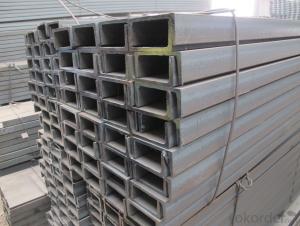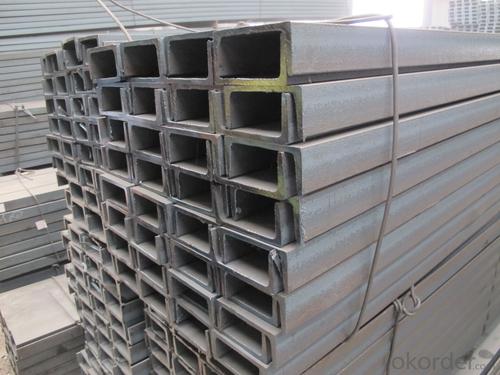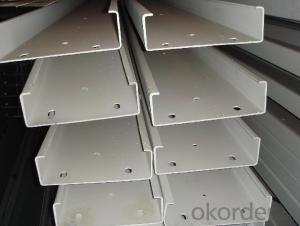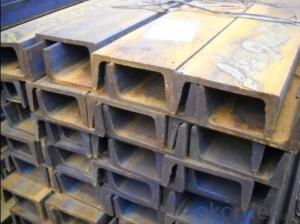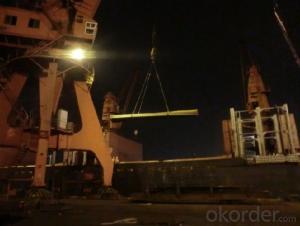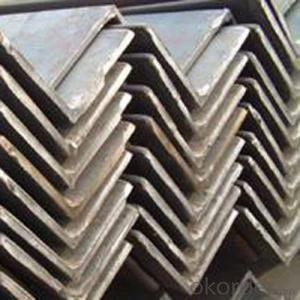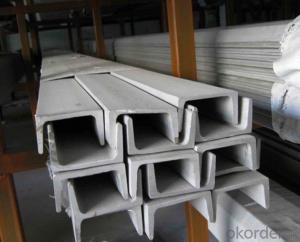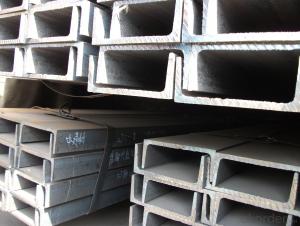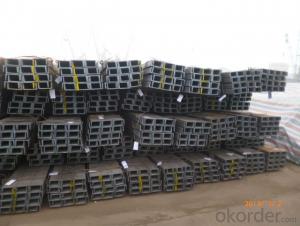Prime Low Carbon Hot Rolled JIS U Channel
- Loading Port:
- China Main Port
- Payment Terms:
- TT or LC
- Min Order Qty:
- 100 m.t.
- Supply Capability:
- 10000 m.t./month
OKorder Service Pledge
OKorder Financial Service
You Might Also Like
Product Description:
OKorder is offering Prime Low Carbon Hot Rolled JIS U Channel at great prices with worldwide shipping. Our supplier is a world-class manufacturer of steel, with our products utilized the world over. OKorder annually supplies products to African, South American and Asian markets. We provide quotations within 24 hours of receiving an inquiry and guarantee competitive prices.
Product Applications:
Prime Low Carbon Hot Rolled JIS U Channel are ideal for structural applications and are widely used in the construction of buildings and bridges, and the manufacturing, petrochemical, and transportation industries.
Product Advantages:
OKorder's Prime Low Carbon Hot Rolled JIS U Channel are durable, strong, and wide variety of sizes.
Main Product Features:
· Premium quality
· Prompt delivery & seaworthy packing (30 days after receiving deposit)
· Can be recycled and reused
· Mill test certification
· Professional Service
· Competitive pricing
Product Specifications:
Manufacture: Hot rolled
Grade: Q195 – 235
Certificates: ISO, SGS, BV, CIQ
Length: 6m-12m, as per customer request
Packaging: Export packing, nude packing, bundled
| JIS STANDARD CHANNEL | ||||||
| SIZE(MM) | h(mm) | b(mm) | s(mm) | t(mm) | kg/m | length |
| 50x25x3x6 | 50 | 25 | 3 | 6 | 2.37 | 6m,12m |
| 75X40x3.8x7 | 75 | 40 | 3.8 | 7 | 5.3 | 6m,12m |
| 75X40x4x7 | 75 | 40 | 4 | 7 | 5.6 | 6m,12m |
| 75X40x4.5x7 | 75 | 40 | 4.5 | 7 | 5.85 | 6m,12m |
| 75X40x5x7 | 75 | 40 | 5 | 7 | 6.92 | 6m,12m |
| 100X50x3.8x6 | 100 | 50 | 3.8 | 6 | 7.3 | 6m,12m |
| 100X50x4.2x6 | 100 | 50 | 4.2 | 6 | 8.03 | 6m,12m |
| 100X50x4.5x7.5 | 100 | 50 | 4.5 | 7.5 | 8.97 | 6m,12m |
| 100X50x5x7.5 | 100 | 50 | 5 | 7.5 | 9.36 | 6m,12m |
| 125X65x5.2x6.8 | 125 | 65 | 5.2 | 6.8 | 11.66 | 6m,12m |
| 125X65x5.3x6.8 | 125 | 65 | 5.3 | 6.8 | 12.17 | 6m,12m |
| 125X65x5.5x8 | 125 | 65 | 5.5 | 8 | 12.91 | 6m,12m |
| 125X65x6x8 | 125 | 65 | 6 | 8 | 13.4 | 6m,12m |
| 150x75x5.5x7.3 | 150 | 75 | 5.5 | 7.3 | 14.66 | 6m,12m |
| 150x75x5.7x10 | 150 | 75 | 5.7 | 10 | 16.71 | 6m,12m |
| 150x75x6x10 | 150 | 75 | 6 | 10 | 17.9 | 6m,12m |
| 150x75x6.5x10 | 150 | 75 | 6.5 | 10 | 18.6 | 6m,12m |
FAQ:
Q1: How many tons of steel products could be loaded in containers?
A1: Usually the steel products are delivered by bulk vessel because of the large quantity and the freight. However, there are no bulk vessel enter some seaports so that we have to deliver the cargo by containers. The 6m steel product can be loaded in 20FT container, but the quantity is changed according to the size, usually from 18tons to 25tons.
Q2: How do we guarantee the quality of our products?
A2: We have established an advanced quality management system which conducts strict quality tests at every step, from raw materials to the final product. At the same time, we provide extensive follow-up service assurances as required.
Q3: How soon can we receive the product after purchase?
A3: Within three days of placing an order, we will arrange production. The normal sizes with the normal grade can be produced within one month. The specific shipping date is dependent upon international and government factors, the delivery to international main port about 45-60days.
Images:
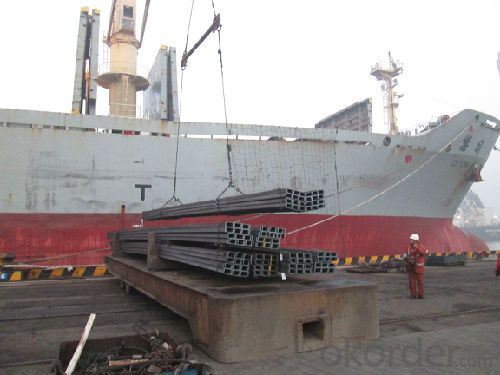
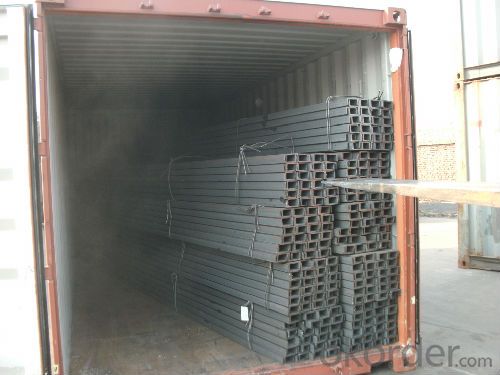
- Q: Can steel channels be used in the construction of support beams?
- Indeed, support beams in construction can be made using steel channels. Renowned for their robustness and endurance, steel channels are widely utilized as structural elements in the construction industry. Their ability to withstand substantial loads and ensure structural stability makes them an ideal option for support beams. Furthermore, steel channels can be tailor-made and manufactured to fit the exact specifications of the construction project, granting them exceptional versatility for support beam construction. Moreover, their resistance to corrosion and fire further augments their suitability for support beam applications.
- Q: What angles, angles and channels are used in general? Please try to be specificWhat are the shapes used in construction?
- Many, steel column, steel beam, steel roof truss, curtain wall steel skeleton, billboard skeleton, special door....
- Q: Can steel channels be used for creating support structures for HVAC systems?
- Yes, steel channels can be used for creating support structures for HVAC systems. Steel channels provide strength, stability, and durability required to support the weight and vibrations of HVAC components such as ductwork, pipes, and units. Their design flexibility and ability to withstand heavy loads make them a suitable choice for constructing reliable and long-lasting support structures for HVAC systems.
- Q: Can steel channels be used for elevator shafts?
- Indeed, it is possible to utilize steel channels in the construction of elevator shafts. Steel channels, characterized by their steel composition and "C" shape, are frequently employed in construction projects for a range of purposes, including elevator shafts. By incorporating steel channels into the design, the elevator shaft structure gains enhanced strength, stability, and support, enabling it to withstand the substantial weight and load of the elevator car, as well as any supplementary loads like individuals or heavy machinery. Moreover, steel channels can be conveniently manufactured and tailored to match the precise specifications of the elevator shaft, rendering them an appropriate selection for this particular application.
- Q: How do steel channels perform in high-temperature applications?
- Steel channels perform well in high-temperature applications due to their excellent heat resistance and structural stability. The inherent strength and durability of steel allow channels to withstand extreme temperatures without significant deformations or weakening. Additionally, steel's thermal conductivity helps distribute heat evenly, preventing localized hotspots. Overall, steel channels are reliable and efficient in high-temperature environments, making them suitable for various industrial applications such as furnaces, heaters, and exhaust systems.
- Q: Can steel channels be used in seismic design?
- Seismic design can make effective use of steel channels, also referred to as steel C channels or C beams. These channels are widely utilized in seismic design due to their exceptional strength, stability, and ductility. The main objective of seismic design is to ensure that structures are capable of withstanding the powerful forces produced during an earthquake. Steel channels are commonly employed as structural components in earthquake-resistant building systems because they possess the ability to absorb and dissipate energy. They exhibit a high capacity for carrying loads, demonstrate exceptional resistance to bending and torsion, and effectively endure lateral forces resulting from seismic activity. Furthermore, steel channels can be tailored and manufactured to meet specific requirements of seismic design, such as incorporating thicker steel plates or additional reinforcement. In summary, steel channels are a versatile and dependable choice for various seismic design applications.
- Q: Are steel channels suitable for the mining parts manufacturing industry?
- The mining parts manufacturing industry finds steel channels to be a suitable choice. Steel channels are frequently utilized in various industries, mining included, thanks to their strength, durability, and versatility. They offer structural support and stability, making them perfect for manufacturing robust and reliable mining parts. In the mining industry, heavy-duty equipment, machinery, and components must endure harsh conditions and extreme forces. Therefore, steel channels, with their excellent load-bearing capacity and impact resistance, are well-suited for producing mining parts like support beams, frames, and brackets. Furthermore, steel channels can be fabricated to meet specific dimensional requirements, allowing manufacturers to create customized parts tailored to the unique needs of the mining industry. They can be easily cut, welded, and shaped into intricate forms, enabling the production of complex mining components. Moreover, steel channels possess corrosion resistance, a vital trait in mining environments that often involve exposure to moisture, chemicals, and abrasive materials. This corrosion resistance prolongs the lifespan of mining parts, reducing the need for frequent replacements or repairs and ultimately enhancing operational efficiency while reducing costs. Additionally, steel channels are readily available and cost-effective for the mining parts manufacturing industry. The widespread use of steel channels also means that there is abundant expertise and knowledge in working with this material, allowing for efficient production processes and reliable quality control. In conclusion, steel channels are highly suitable for the mining parts manufacturing industry due to their strength, durability, versatility, corrosion resistance, and cost-effectiveness. These qualities make steel channels an ideal choice for producing mining parts that can withstand the demanding conditions and requirements of the mining industry.
- Q: Are steel channels resistant to pest infestation?
- Yes, steel channels are highly resistant to pest infestation. Unlike wood, which can be vulnerable to pests such as termites and rodents, steel channels provide a durable and impenetrable barrier that pests cannot easily access or damage.
- Q: What are the different types of accessories used with steel channels in construction?
- There are several different types of accessories used with steel channels in construction, including brackets, connectors, clamps, and fasteners. These accessories are used to secure the steel channels in place, connect them to other structural components, provide additional support, and enhance their overall functionality.
- Q: What are the different finishes available for steel channels?
- There exists a variety of finishes for steel channels, each serving a specific purpose and offering unique advantages. Some of the most prevalent finishes include: 1. Hot-dip galvanization: This finish involves immersing the steel channel in a molten bath of zinc, which results in a robust and thick coating that offers exceptional resistance against corrosion. Hot-dip galvanized channels are commonly utilized in outdoor settings or in situations where the steel is exposed to moisture or harsh conditions. 2. Powder coating: Powder coating entails the application of a dry powder onto the steel channel, followed by baking it in an oven to produce a hard and protective layer. This finish is available in an extensive range of colors and provides good resistance against corrosion, impacts, and durability. Powder-coated steel channels are frequently employed in architectural applications or scenarios where aesthetics are of utmost importance. 3. Electroplating: Electroplating is the process of depositing a thin layer of metal, such as zinc or chrome, onto the steel channel through an electrochemical procedure. This finish offers corrosion resistance and can enhance the appearance of the channel. Electroplated steel channels are commonly used in decorative or automotive applications. 4. Painting: Steel channels can also be painted with different types of coatings, including epoxy, acrylic, or enamel paint. Painting creates a protective barrier against corrosion and can also enhance the visual appeal of the channel. Painted steel channels are commonly found in indoor applications or situations where specific colors are required. 5. Stainless steel: Stainless steel channels naturally possess a corrosion-resistant finish due to the high levels of chromium present in the alloy. This finish is ideal for applications where the channel will be exposed to high levels of moisture or chemicals. These examples illustrate the diverse range of finishes available for steel channels. The choice of finish depends on factors such as the intended use, environmental conditions, and desired appearance of the channel.
Send your message to us
Prime Low Carbon Hot Rolled JIS U Channel
- Loading Port:
- China Main Port
- Payment Terms:
- TT or LC
- Min Order Qty:
- 100 m.t.
- Supply Capability:
- 10000 m.t./month
OKorder Service Pledge
OKorder Financial Service
Similar products
Hot products
Hot Searches
Related keywords
